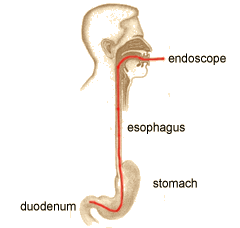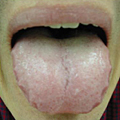|
The most accurate method available to determine the presence of peptic ulcer disease (PUD) is through endoscopic examination of the upper gastrointestinal (GI) tract. This procedure uses a fiber optic instrument called an endoscope that is composed of a flexible tube and a lighted mirror lens system. The device allows your doctor to directly visualize and examine your esophagus, stomach and duodenum. A local anesthetic spray is applied to the throat to prevent gagging and the endoscope is placed in the mouth, passed through the throat, along the esophagus, and into the stomach and duodenum. In people with suspected PUD, this procedure may be used to determine the cause of bleeding, look for the presence of ulcers or inflammation, to perform a tissue biopsy to look for cancer cells or h. pylori, or to evaluate ulcer healing after a course of medication has been given.
 |
| Endoscopic examination of the upper gastrointestinal tract |
If you are going to have an endoscopy performed you must not eat anything for 6 hours before the procedure. You also need to avoid using antacids after 10:00pm on the day before the procedure. In addition to the local anesthetic mentioned above, your doctor may give you several medications beginning 30 minutes before the examination. These medications include atropine to decrease secretions, narcotics and benzodiazepines (i.e. fentanyl and midazolam) to decrease anxiety, decrease discomfort and provide mild sedation.
There are several methods for diagnosing the presence of h. pylori infection. These include tissue biopsy for culture or CLO test, blood test for the presence of antibodies, the carbon-isotope breath test or a fecal test. Medications such as antibiotics, proton pump inhibitors, bismuth subsalicylate and sucralfate may cause false negative results for the breath test. You should avoid these medications for two weeks before taking the breath test for h. pylori.
It is well known that duodenal ulcer is caused by h. pylori infection in 95% of cases in people who are not taking NSAIDs. If this applies to you, your doctor may prescribe antibiotics for h. pylori eradication without doing a test for it first as this has become a safe and acceptable medical practice.
|
| |
|
|
Diagnosis in TCM places importance on determining the circumstances and manifestations of a disease through inquiry and observation of symptoms. A diagnosis is based on the traditional four examination techniques:
| 1. |
Questioning The TCM practitioner will establish the medical history of both the patient and his family. |
| 2. |
Observation Examination of the physical features of the body, such as the face, tongue, hair, nails, sputum (mucus that is coughed up), and location of pain, all offer clues to the problem. The tongue is a particularly useful indicator of the functioning of the internal organs. |
| 3. |
Listening and smelling The smelling of sputum and breath and listening to the sounds produced by the chest offer additional clues to the patient's health. |
| 4. |
Touching Feeling the pulse is a cornerstone of TCM diagnosis and gives the practitioner much information about any bodily imbalance. |
For details, please see article on "What to Expect from a TCM Doctor's Examination".
TCM practitioners will usually begin with a thorough investigation of the patient's complaints and categorize the symptoms under special syndrome groups known as "disharmony patterns." The disharmony patterns are present at different stages of a disorder. The practitioners will look at both the major manifestations, and "disharmony patterns" which are described below:
1. Qi stagnation
The patient feels distending pain in the epigastric region, and fullness and oppression in the hypochondrium (the upper lateral sides of the abdomen). These symptoms would worsen with emotional disturbance, and can be relieved by discharge of intestinal gas or belching. The patient tends to sigh, has a poor appetite and experiences oppression in the chest and sour regurgitation. On examination, the tongue is covered by a thin white fur, and the pulse is taut.
2. Heat retention
The patient feels a burning pain in the epigastric area. Eating offers no obvious relief; instead, it may even make the symptoms worse. The mouth is dry with a bitter taste. Other symptoms include thirst and a desire for cold drinks, sour regurgitation, irritability, clamoring stomach and constipation. On examination, the tongue is red with yellow fur, and the pulse is taut or rapid.
3. Yin deficiency
The patient feels a dull, burning epigastric pain which becomes worse on an empty stomach. Other associated symptoms include thirst and a disinclination to drink, dryness of the mouth, poor appetite, retching, constipation, and a feverish sensation in the palms, soles and chest. On examination, the tongue is red and dry, with cracks in the central portion. It is covered with little or scattered, cracked fur. The pulse is thready or rapid.
 |
| A pale tongue with indented margin, the cracks in the central portion indicate spleen and stomach dysfunction. |
4. Deficient cold
The patient feels a dull epigastric pain which tends to ease with warmth and massage. An attack can be easily induced or worsened by over-exertion. The pain worsens on an empty stomach. Although the pain can be relieved by eating, abdominal distention will follow. Other associated symptoms are fatigue, sleepy, reluctance to speak, and loose stools. On examination, the tongue is pale and bulky with indented margin, and it is covered by a thin white fur. The pulse is deep, thready or slow.
5. Blood stasis
The patient experiences a fixed, stabbing pain in the epigastric area. But when the pain becomes extreme, it sometimes radiates towards the chest and the back. This may be accompanied by coldness of the limbs, sweating, vomitting blood or blood in the stools. On examination, the tongue is dark purple, and may have bruises or patches on the surface. The pulse is hesitant.
In general, during the pathological course of peptic ulcer, the above syndromes develop at different stages. In the early or active stages of peptic ulcer, qi stagnation and heat retention syndromes are quite common. TCM terms these as a sthenia or excess (shi) syndromes in which the body offers a relatively strong resistance.
In the late or recovery stages of peptic ulcer, yin deficiency and deficient cold syndromes are more common. TCM terms these as a sthenia or deficiency (xu) syndromes in which the body's resistance is very weak.
Blood stasis syndromes can develop at any stage, but occurs mostly in the middle and late stages. The syndrome has a deficiency nature but presents excitatory signs, or having both excess and deficiency syndromes inter-mixed.
|
| |
|